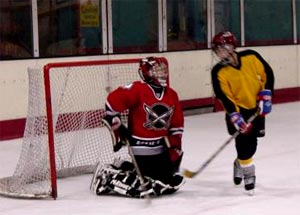 Get your dose of Basketball, India, Philosophy, and everything else in between... in 140 characters or less..!
Get your dose of Basketball, India, Philosophy, and everything else in between... in 140 characters or less..!Hoopistani is now on Twitter: http://twitter.com/hoopistani.
Contact me @hoopistani.
 Get your dose of Basketball, India, Philosophy, and everything else in between... in 140 characters or less..!
Get your dose of Basketball, India, Philosophy, and everything else in between... in 140 characters or less..! One such effort has been by the 'Hoops for Health' basketball school that has been making a difference in the lives children under extremely hostile conditions in Kashmir, breaking language, cultural, and national barriers. There is no better way to rehabilitate some of these youngsters who have already been through atrocities in their young lives than through lessons and activities of sport. The project is a collaboration between basketball school jdBasketball and independent, non-profit organization Child Nurture and Relief (CHINAR).
One such effort has been by the 'Hoops for Health' basketball school that has been making a difference in the lives children under extremely hostile conditions in Kashmir, breaking language, cultural, and national barriers. There is no better way to rehabilitate some of these youngsters who have already been through atrocities in their young lives than through lessons and activities of sport. The project is a collaboration between basketball school jdBasketball and independent, non-profit organization Child Nurture and Relief (CHINAR). The last date for the 2010 Beyond Sport Awards entries is April 16, 2010. A shortlist of the nominations will be revealed in May, and the winners of the awards will be unveiled at the Beyond Sport Summit from September 27-30 2010 in Chicago.
The last date for the 2010 Beyond Sport Awards entries is April 16, 2010. A shortlist of the nominations will be revealed in May, and the winners of the awards will be unveiled at the Beyond Sport Summit from September 27-30 2010 in Chicago.  "Kobe!" says Zyman.
"Kobe!" says Zyman.  Almost exactly two years prior to that incident, Arenas is voted the best celebrity blogger by the 2007 Weblog Awards. He becomes the world's first blog superstar, and his hilarious and honest writings about life as an NBA superstar make him the most loved and approachable player in the league. He was the player's player, a fan of the game just like every fan that followed him.
Almost exactly two years prior to that incident, Arenas is voted the best celebrity blogger by the 2007 Weblog Awards. He becomes the world's first blog superstar, and his hilarious and honest writings about life as an NBA superstar make him the most loved and approachable player in the league. He was the player's player, a fan of the game just like every fan that followed him.  While the investigation is in process, Arenas continues to take matters lightly, and being famously photographed making finger-gun signs during Wizards pre-game warm-up.
While the investigation is in process, Arenas continues to take matters lightly, and being famously photographed making finger-gun signs during Wizards pre-game warm-up.  March 26, 2010, four days ago, Arenas was convicted of his crimes. He was sentenced to 30 days in a halfway house and two years probation.
March 26, 2010, four days ago, Arenas was convicted of his crimes. He was sentenced to 30 days in a halfway house and two years probation.  I'm back in 2007 now. Back at the Royal Park Court. Back shooting three-pointers with a "Hibachi" shoutout, and back turning my back to celebrate the baskets even before they go in. My inspiration is Arenas, one of my favourite players, and certainly one of the most perplexing individuals in basketball. It's difficult to like him after all the foolishness and the mistakes, and it's difficult to hate someone like him with such an explosive talent and fan-friendly personality. Maybe that's the reason why he's one of my top five nominees of current NBA players that I would like to see visit India.
I'm back in 2007 now. Back at the Royal Park Court. Back shooting three-pointers with a "Hibachi" shoutout, and back turning my back to celebrate the baskets even before they go in. My inspiration is Arenas, one of my favourite players, and certainly one of the most perplexing individuals in basketball. It's difficult to like him after all the foolishness and the mistakes, and it's difficult to hate someone like him with such an explosive talent and fan-friendly personality. Maybe that's the reason why he's one of my top five nominees of current NBA players that I would like to see visit India. 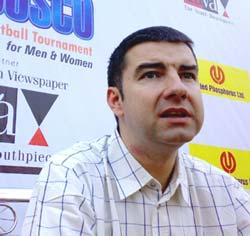 Krishnakumar KH from Express Buzz interviewed Alexsander Bucan, the head coach of the Indian Men's basketball team, during Coaches Coaching Clinic in Kochi a few weeks ago. Bucan, an experienced Serbian coach, has been in-charge of the Young Cagers for around two years. Here are some excerpts from that interview:
Krishnakumar KH from Express Buzz interviewed Alexsander Bucan, the head coach of the Indian Men's basketball team, during Coaches Coaching Clinic in Kochi a few weeks ago. Bucan, an experienced Serbian coach, has been in-charge of the Young Cagers for around two years. Here are some excerpts from that interview:India, says Bucan, has the potential to bloom in the ‘simple’ business of getting through a maze of giant bodies to ram a huge ball through a basket raised high on a pole. Easier said than done, he accepts. But if China, Russia and Iran can do it, so can India, feels the affable Bucan...
“The Russians and the Chinese are not the biggest of people,” he points out. “But they have tall players in their basketball and volleyball teams. That means they identified talent at an early age and put them through scientific training to produce world-class athletes. The same is possible in India.” But Bucan contends that producing world-class athletes requires an overhaul of the “amateurish system” in India. “It is professionalism that gets you results,” he says. “You need to begin early and find young talent with the right build. Then they need systematic training that includes fitness training, nutritional care and psychology sessions.” The Serb has no doubt India has the talent. “I have seen many talented players at the school and college levels in India. Some are more gifted than the national players. Sadly, most of them drop off the game to further their studies or go looking for jobs. No one is really interested in leaving everything else behind and concentrating solely on the game.”
“There is no way the team can improve without playing strong opposition regularly,” he says. Further, Bucan is not one to boast without a blueprint — infrastructure, academies, age-group tournaments, camps, a professional national league at the senior level and cheering crowds.
“Just because you bring in a foreign coach, for any game, there is no guarantee the quality will improve,” he says.However, the national coach is quick to point out the improvement made by the cagers in the past few years. “There has been a big difference in standards in the past two years,” he says. “But the real difference can be made only with long-term strategies. Stress should be laid on the under-16 level to unearth players with potential.”
The most significant achievement during the past two years is the triumph of the Indian under-17 team at the 2008 Asian FIBA 33 championship — which allows just three players per team. It was the first time an Indian basketball team at any level had achieved such a feat. “We beat the Philippines, where basketball is as big as cricket in India,” says Bucan.
Regarding coaching, he feels it is tactical play that requires greater attention once the basics are in place. “We are far behind world-class standards in terms of contact play,” he says. “Also, there has to be more set play than what the players are used to here.”
 In India, our favorite pastime is cricket. Every thin lane, or gullie in India is a cricket pitch, every wooden stick a bat, every round object a ball. It is deeply embedded in modern Indian culture — the majority of Indian societies see children having impromptu cricket matches in their neighborhood, by the ghats of the Ganga, every barren field is a stadium, cricket references and metaphors have become part of everyday speak in the country, and get-togethers in roadside tea-shops only discuss cricket scores.
In India, our favorite pastime is cricket. Every thin lane, or gullie in India is a cricket pitch, every wooden stick a bat, every round object a ball. It is deeply embedded in modern Indian culture — the majority of Indian societies see children having impromptu cricket matches in their neighborhood, by the ghats of the Ganga, every barren field is a stadium, cricket references and metaphors have become part of everyday speak in the country, and get-togethers in roadside tea-shops only discuss cricket scores. So when the NBA decided to tap the 1.2 billion strong Indian market to popularize basketball, they knew they were up against some tough competition. After launching an NBA-India website, their most recent development has been a deal with rich industrial conglomerate Mahindra Group to launch a recreational league in three Indian cities: Mumbai, Bangalore, and Ludhiana. The league will tip off in a month’s time and will last for seven weeks.
So when the NBA decided to tap the 1.2 billion strong Indian market to popularize basketball, they knew they were up against some tough competition. After launching an NBA-India website, their most recent development has been a deal with rich industrial conglomerate Mahindra Group to launch a recreational league in three Indian cities: Mumbai, Bangalore, and Ludhiana. The league will tip off in a month’s time and will last for seven weeks. For India, one such movement to popularize basketball into rural and grassroots lifestyle is the Sumpoorna Basketball School. Sumpoorna is the name of a basketball camp — or like its founder Subhash Mahajan likes to call “a grassroots basketball revolution” — that has been slowly growing in small, rural town of Tumkur in Southern India over the past five years. Driven by a lifelong love of basketball, Mahajan has set up this basketball camp mostly for small town and village youth, which has grown over the years to have taught basketball basics to up to 6,000 youngsters around the rural area, and launched the Sumpoorna Basketball Tournament where dozens of small school and recreational teams compete against each other.
For India, one such movement to popularize basketball into rural and grassroots lifestyle is the Sumpoorna Basketball School. Sumpoorna is the name of a basketball camp — or like its founder Subhash Mahajan likes to call “a grassroots basketball revolution” — that has been slowly growing in small, rural town of Tumkur in Southern India over the past five years. Driven by a lifelong love of basketball, Mahajan has set up this basketball camp mostly for small town and village youth, which has grown over the years to have taught basketball basics to up to 6,000 youngsters around the rural area, and launched the Sumpoorna Basketball Tournament where dozens of small school and recreational teams compete against each other. As the awareness and interest for the game has spread, Mahajan has been able to organize large tournaments, and is looking to get larger. “We want to tie up with more schools, especially from the bigger cities, so that they can learn basics. I want them to live the game and not just play it.” A major step that Mahajan is looking to take with Sumpoorna is to invite senior basketball players in India to oversee and promote the Sumpoorna tournaments.
As the awareness and interest for the game has spread, Mahajan has been able to organize large tournaments, and is looking to get larger. “We want to tie up with more schools, especially from the bigger cities, so that they can learn basics. I want them to live the game and not just play it.” A major step that Mahajan is looking to take with Sumpoorna is to invite senior basketball players in India to oversee and promote the Sumpoorna tournaments. NBA players have been to India before, obviously - no disrespect, but enough with the Kyle Korvers and Ronny Turiafs... The biggest stars to have been in India in recent years have been Robert Parish and Dominique Wilkins (both long retired), Baron Davis (who held youth clinics in India) and Kevin Garnett (who came as part of an adidas promotional tour).
NBA players have been to India before, obviously - no disrespect, but enough with the Kyle Korvers and Ronny Turiafs... The biggest stars to have been in India in recent years have been Robert Parish and Dominique Wilkins (both long retired), Baron Davis (who held youth clinics in India) and Kevin Garnett (who came as part of an adidas promotional tour).  1. Kobe Bryant: A no-brainer. The biggest name in basketball today, the champion, Finals MVP. India has been force-fed Kobe and the Lakers for an entire decade, back when Kobe ran with Shaq uptil now, when he runs with Gasol, Artest, Odom, and Bynum. The Lakers as a brand are also one of the most popular teams in India.
1. Kobe Bryant: A no-brainer. The biggest name in basketball today, the champion, Finals MVP. India has been force-fed Kobe and the Lakers for an entire decade, back when Kobe ran with Shaq uptil now, when he runs with Gasol, Artest, Odom, and Bynum. The Lakers as a brand are also one of the most popular teams in India.  4. Dwyane Wade: Wade is my favourite basketball player, and the most talented one outside of Kobe-LeBron (sorry Durant, Dwight, Melo, etc). I'd love to see him visit India, and subsequently, gain more popularity since he is still underrated internationally (shocking!!). The former NBA champion, Finals MVP, and this year's All Star MVP needs more exposure to my fellow countrymen who have otherwise been binging on Laker and Cavalier game - unfortunately, the Heat are just not succesful enough these days for him to make the same kind of waves.
4. Dwyane Wade: Wade is my favourite basketball player, and the most talented one outside of Kobe-LeBron (sorry Durant, Dwight, Melo, etc). I'd love to see him visit India, and subsequently, gain more popularity since he is still underrated internationally (shocking!!). The former NBA champion, Finals MVP, and this year's All Star MVP needs more exposure to my fellow countrymen who have otherwise been binging on Laker and Cavalier game - unfortunately, the Heat are just not succesful enough these days for him to make the same kind of waves.  - Ron Artest: I would love to see him getting pissed off, when stuck in the Mumbai traffic, another commuter calls him out.
- Ron Artest: I would love to see him getting pissed off, when stuck in the Mumbai traffic, another commuter calls him out.  Hey, I always knew the Spurs have an eye for great foreign players - Tony Parker, Manu Ginobili, and Tim Duncan isn't exactly American, either (Virgin Islands, actually). Looking for the next big thing by making contacts in India already?
Hey, I always knew the Spurs have an eye for great foreign players - Tony Parker, Manu Ginobili, and Tim Duncan isn't exactly American, either (Virgin Islands, actually). Looking for the next big thing by making contacts in India already?Talking about the initiative, Udit Sheth, MD and CEO of TransStadia says “Sport has ceased to be a vocational activity and has emerged as a billion dollar industry. We aim at bringing together a potpourri of global and Indian sports celebrities and administrators, under one roof to come up with ideas to transform Indian sports.”
He adds, "There is tremendous change in the way we look at sports in India. It is on par with any other industry. Innovative sports development events such as the IPL have clearly put sports in a pole position. Unfortunately, Indian sports is divided and fragmented and lacks collective thinking. We need to chart a new path and aim to do that by bringing in the best of talent in sports administration, government, people connected to sports infrastructure and the media on a single platform," says Sheth.
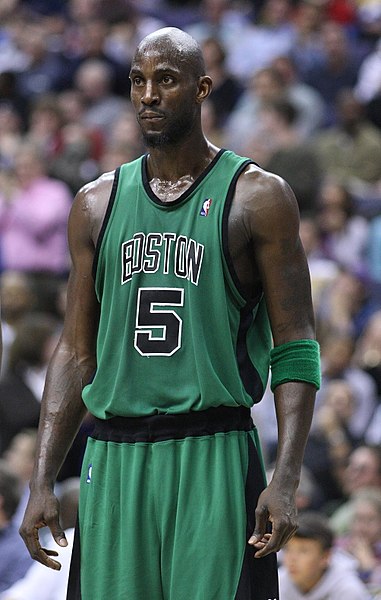 Switch on a Boston Celtic game now, and when you see Kevin Garnett struggling to pace up and down the basketball court, getting lost on the offensive end, and failing to match his outward intensity with efficient play, a new NBA fan may be fooled in believing that the thin 6’11” power forward could have ever been better than the 14 points and seven and a half rebounds per game he has averaged this season.
Switch on a Boston Celtic game now, and when you see Kevin Garnett struggling to pace up and down the basketball court, getting lost on the offensive end, and failing to match his outward intensity with efficient play, a new NBA fan may be fooled in believing that the thin 6’11” power forward could have ever been better than the 14 points and seven and a half rebounds per game he has averaged this season.  Garnett spent 12 long, hard, and exemplarily loyal years with the T-Wolves, taking a below average team to the playoffs for eight straight years from 1997-2004. And below average is right, for except for that successful 2003-04 season, the best players that Garnett played with for the rest of those eight years was Wally Szczerbiak. Wally friggin Szearayaerabziaakkk!!!
Garnett spent 12 long, hard, and exemplarily loyal years with the T-Wolves, taking a below average team to the playoffs for eight straight years from 1997-2004. And below average is right, for except for that successful 2003-04 season, the best players that Garnett played with for the rest of those eight years was Wally Szczerbiak. Wally friggin Szearayaerabziaakkk!!!  And there’s yet another reason why I have a special affinity towards Da Kid: In July 2006, as part of a now-struggling Timberwolves team and constantly bothered by trade rumours, KG came to India as part of a promotional tour for adidas. The tour stopped in several Indian cities, and you can read about it here on KG’s Asia tour blog.
And there’s yet another reason why I have a special affinity towards Da Kid: In July 2006, as part of a now-struggling Timberwolves team and constantly bothered by trade rumours, KG came to India as part of a promotional tour for adidas. The tour stopped in several Indian cities, and you can read about it here on KG’s Asia tour blog. 
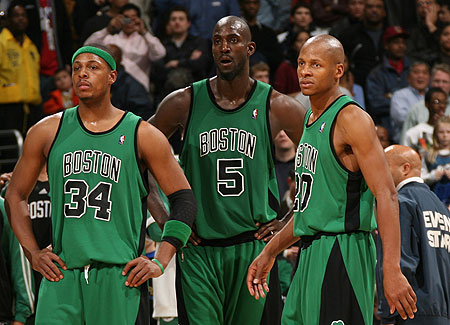 What happened the following season is stuff of folklore. KG joined Paul Pierce and Ray Allen in the Celtics to form a formidable ‘Big Three’, who went on to have the best record in the NBA with 66 wins, posting the best single-season turnaround in NBA history, improving by 42 wins from the previous season. Imagine that! The second-worst team gives up six players for one player, finds another sharp-shooter in Allen, and becomes the best team. It’s incredible.
What happened the following season is stuff of folklore. KG joined Paul Pierce and Ray Allen in the Celtics to form a formidable ‘Big Three’, who went on to have the best record in the NBA with 66 wins, posting the best single-season turnaround in NBA history, improving by 42 wins from the previous season. Imagine that! The second-worst team gives up six players for one player, finds another sharp-shooter in Allen, and becomes the best team. It’s incredible. 
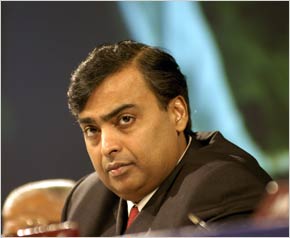 IMG-Reliance will also develop professional basketball and football leagues in India, nurture young talent at the academies, and train coaches in these sports as well.
IMG-Reliance will also develop professional basketball and football leagues in India, nurture young talent at the academies, and train coaches in these sports as well. The new company, IMG Reliance, would set up sports facilities across the country to train athletes, thus developing the sports market. The model would be similar to the one followed in mature sports and entertainment markets such as the US. The companies plan to create and operate major sports and entertainment assets.
Mukesh Ambani, chairman and managing director, Reliance Industries, said: "Development of sports and the sporting culture is a social imperative for India in the 21st century. World-class infrastructure, frugal engineering, technology and scientific coaching are an integral part of development of today's sporting talent globally."
Plans are underway to create an agency to offer 360-degree sports management to celebrities from the world of sports, Bollywood and fashion. IMG would transfer its existing business and assets in the country to the joint venture. These include the Aircel Chennai Open, the Association of Tennis Professionals World Tour event and Lakmé Fashion Week.
However, the ongoing Indian Premier League would stay with IMG and the company's international business and executive team is to manage it.
Ted Forstmann, chairman and CEO of IMG, said: "The performance of Indian athletes on the national and international stage will improve dramatically with the correct development strategies. As a consequence, the commercial performance of sport and entertainment in India will be enhanced."
The real potential profits from the venture will come from the development of professional sports leagues. The IMG-Reliance venture will look to strike arrangements with India's soccer and basketball federations to help them build these leagues.












